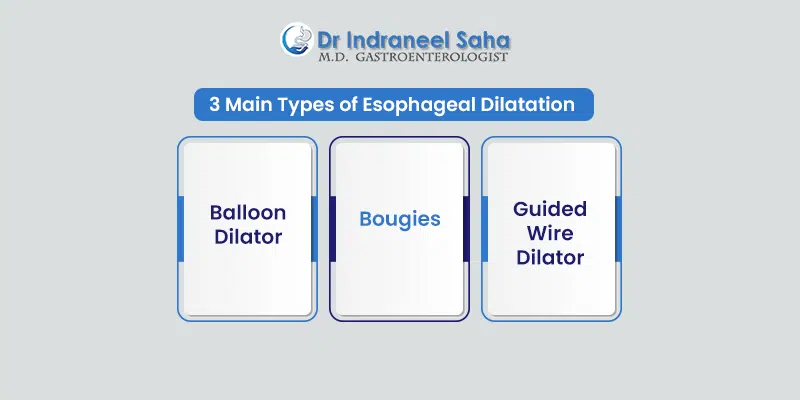- 5th Mar, 2025
- Esophageal Dilatation, Gastroenterologist
Esophageal Dilation: Procedure, Types & Purpose
Do you often feel like something is stuck in your throat? Well, this could be due to the narrowing of your esophagus. This is a common condition and is known as esophageal stricture.
An individual who has developed esophageal strictures finds it difficult to swallow food and liquids because the food particles take a much longer time to move into the stomach. If left untreated for a longer duration, it also leads to pain, discomfort and even malnutrition.
So, what is the solution to this problem? The answer is esophageal dilatation, which is an effective procedure to widen the muscles of the esophagus to make swallowing easier.
In this blog, we will explore everything related to esophageal dilation, including the procedure, types and purpose.
What is Esophageal Dilatation?
Esophageal dilatation is a medical procedure that is used to widen a narrowed esophagus (a tube that connects the mouth to the stomach).
When the esophagus gets constricted, it becomes difficult for foods and liquids to pass through it into the stomach, leading to difficulty in swallowing (a condition known as dysphagia).
Patients with esophageal stricture always have a sensation that something is always choked into the throat. For them, esophageal dilatation is the most effective way to widen open the parts of the esophagus that are too narrow.
During the procedure, gastroenterologists insert an endoscope that has a balloon attached to the end through the mouth to the esophagus. Patients are generally sedated before the examination to minimise any kind of pain and discomfort.
Once your doctor identifies the narrowed area, the balloon is dilated at the site of the stricture to expand the walls of the esophagus, thereby allowing the food to pass through quite easily.
Three Main Types of Esophageal Dilatation
There are three primary types of esophageal dilatation each with its own technique and purpose. Now, the kind of method patients are required to undergo is determined by the severity of the stricture.
- Balloon dilator: Here a balloon catheter is inserted into the endoscope and slowly filled with air near the stricture to widen the narrowed area. During the process, the balloon is inflated and then deflated for some time. The procedure might be repeated as required by the patients.
- Bougies: These are cone-shaped tubes of various sizes. Here the bougies are passed down to the esophagus to widen its walls. The gastroenterologists usually start with the smaller ones, and then larger ones are used until the stricture is widened to the right amount. It is mainly a preferred method for strictures that are simple, short and straight.
- Guided wire dilator: In this method, a thin wire is passed down the esophagus which has a small tube that is wider at the end. The wire is then put into the stricture to widen its narrowed portions.

Why is Esophageal Dilatation Recommended?
Dr. Indraneel Saha, a well-reputed gastroenterologist, listed several reasons why esophageal dilatation is needed for patients.
- Relief from swallowing difficulty (dysphagia): It is probably one of the common purposes why patients are advised esophageal dilatation. The process is done to ease the pain and discomfort that comes with swallowing difficulty.
- Treat esophageal strictures: The method is also performed to treat esophageal strictures that can be caused by several factors such as:
- GERD
- Esophageal cancer
- Esophagitis
- Achalasia
- Preventing long-term complications: If the narrowing of the esophagus is left unchecked, it can lead to several complications like choking, aspiration pneumonia, esophageal perforation and rupture.
- Improving nutrition: An individual with a narrowed esophagus struggles with swallowing food, which eventually results in malabsorption of nutrition and weight loss. By widening the esophagus with the dilatation method, patients can improve their nutritional intake.
Final Words
Contrary to what most people think, esophageal dilatation is a minimally invasive and completely safe procedure. If you need to undergo it, always get the method done by an experienced gastroenterologist and make sure to follow both pre and post-operative instructions for the best results.